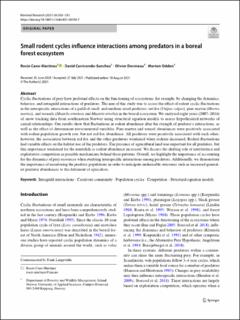Small rodent cycles influence interactions among predators in a boreal forest ecosystem
Peer reviewed, Journal article
Published version
Permanent lenke
https://hdl.handle.net/11250/2994487Utgivelsesdato
2021Metadata
Vis full innførselSamlinger
Sammendrag
Cyclic fuctuations of prey have profound efects on the functioning of ecosystems, for example, by changing the dynamics, behavior, and intraguild interactions of predators. The aim of this study was to assess the efect of rodent cyclic fuctuations in the interspecifc interactions of a guild of small- and medium-sized predators: red fox (Vulpes vulpes), pine marten (Martes martes), and weasels (Mustela erminea and Mustela nivalis) in the boreal ecosystem. We analyzed eight years (2007–2014) of snow tracking data from southeastern Norway using structural equation models to assess hypothesized networks of causal relationships. Our results show that fuctuations in rodent abundance alter the strength of predator’s interactions, as well as the efect of determinant environmental variables. Pine marten and weasel abundances were positively associated with rodent population growth rate, but not red fox abundance. All predators were positively associated with each other; however, the association between red fox and the other predators weakened when rodents increased. Rodent fuctuations had variable efects on the habitat use of the predators. The presence of agricultural land was important for all predators, but this importance weakened for the mustelids as rodent abundance increased. We discuss the shifting role of interference and exploitative competition as possible mechanisms behind these patterns. Overall, we highlight the importance of accounting for the dynamics of prey resources when studying interspecifc interactions among predators. Additionally, we demonstrate the importance of monitoring the predator populations in order to anticipate undesirable outcomes such as increased general ist predator abundances to the detriment of specialists.

